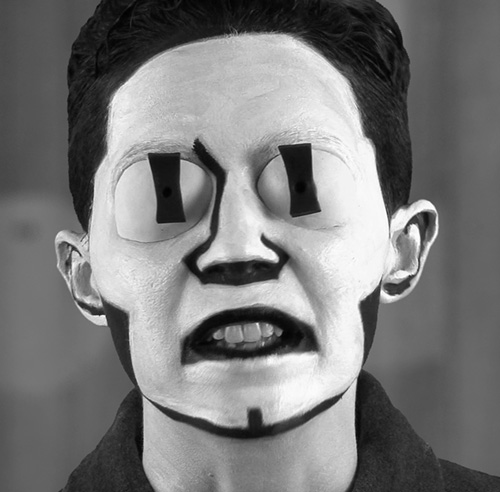Mary Reid Kelley with Patrick Kelley, Sadie, the Saddest Sadist and You Make me Iliad
Kara Pickman

Mary Reid Kelley with Patrick Kelley, You Make Me Iliad, 2010. Black-and-white HD video, with sound, 14 min., 49 sec. Courtesy the artists
January 22, 2015
In connection with its current exhibition Myth and Machine: The First World War in Visual Culture, the Wolfsonian–Florida International University hosted artists Mary Reid Kelley and Patrick Kelley for a screening of two of their WWI-inspired videos: Sadie, the Saddest Sadist (2009) and You Make Me Iliad (2010). Reid Kelley is well known for her forceful intellect, expressed in her extremely clever verse-making, biting and playful wordplay, ethereal screen presence, and her filmmaking itself, which entails meticulously researched production details such as drawn imagery, painstaking stop-motion lettering, and costume and set design digitally enhanced by her collaborator and husband Patrick.
In stark black-and-white makeup, bugged-out and blacked-out eyes, and blackened mouth, Reid Kelley’s factory worker Sadie pronounces, in an exchange with a sailor (also played by the artist), “You’re a sight for sore eyes, and your laugh is infectious. Love’s in the air, and the feeling’s contagious. With a feverish pitch, you toss out the first ball. I’ll catch it, and keep it, Dear Jack, warts and all.” Behind this perfectly pitched rhyme and meter, white letters move against a black background, creating first a set of eyes, then amoeba-like forms that resemble an infection at the cellular level crawling across the screen (timed with “contagious”), then later, in the sailor’s response, the letters spell out: “I know that you care by the Marx on my Lenin.” With their onslaught of verbal winks and dirty jokes, the videos beg to be watched again and again.
But the audience watched each just once, followed by a presentation in which Reid Kelley described her ongoing research of WWI. The interest goes back to her graduate work at Yale University, where she experimented with “found” text by combining words and phrases in short graphite rubbings made at a nearby war memorial where, among many others, men who left the university to enlist during WWI are memorialized. This practice led Reid Kelley to Europe, where she visited the graves of each of these men, continued her graphite rubbings, and documented WWI memorials, which, as she shared with the audience, ranged from classical, to realist, and even to erotic in their depictions of the strong, virile young men who died in the effort.
But the focus of Sadie, the Saddest Sadist and You Make Me Iliad are the women of wartime. The latter depicts a prostitute and soldier in a military brothel much like those that were sanctioned and monitored by military health inspectors at the time. The verbal sparring between Reid Kelley as prostitute and Reid Kelley as young, idealist soldier is as beautiful and delightful as it is frustrating in its opacity. The complexity of the scripts make certain the two characters can’t ever understand each other; likewise, as Kelley pointed out, the audience is kept at bay by the figures’ blocked eyes and the two-dimensional effect of their costuming and makeup—which only further distances us from a connection we might like to make. One visitor commented that the overall effect was like experiencing a “temporary, entertaining dyslexia.” Much to the artists’ delight.










